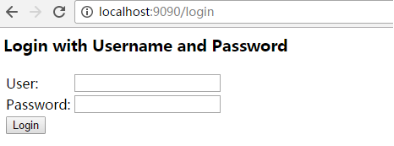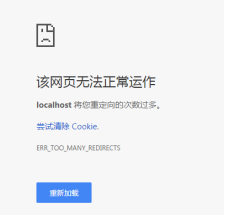1:春のセキュリティプロファイル
春のセキュリティは、CANベースで春のエンタープライズアプリケーションのための安全なアクセス制御宣言型セキュリティフレームワーク・ソリューションを提供します。それは可能のセットを提供スプリング構成アプリケーションコンテキスト豆、フルに活用春のIoC 、DI (制御の反転:依存噴射制御の反転、DI および依存性注入)AOP 機能は、アプリケーションを提供する(アスペクト指向プログラミング)宣言セキュリティアクセス制御機能、作業のコードの重複をたくさん書いて、企業システムのセキュリティ制御を減らします。
1.2春のセキュリティは、はじめにデモ
1.2.1 最も簡単なデモ
( 1)のpom.xmlコンテンツに依存関係を追加し、プロジェクトのスプリング・セキュリティ・デモを作成します。
<プロパティ>
<webVersion> 3.0 </ webVersion>
<spring.version> 4.2。5 .RELEASE </spring.version>
</プロパティ>
<依存性>
<依存性>
<のgroupId> org.springframework </のgroupId>
<たartifactId>ばねコア</たartifactId>
<バージョン> $ {spring.version} </バージョン>
</依存>
<依存性>
<のgroupId> org.springframework </のgroupId>
<たartifactId>ばねウェブ</たartifactId>
<バージョン> $ {spring.version} </バージョン>
</依存>
<依存性>
< groupId> org.springframework <
春・セキュリティ・ウェブ</たartifactId> <バージョン> 4.1。0 .RELEASE </バージョン>
</依存>
<依存性>
<のgroupId> org.springframework.security </のgroupId>
<たartifactId>スプリングセキュリティ設定</たartifactId>
<バージョン> 4.1。0 .RELEASE </バージョン>
</依存>
<依存性>
<groupIdを>のjavax.servlet </のgroupId>
<たartifactId>サーブレットAPI </たartifactId>
<バージョン> 2.5 </バージョン>
<スコープ>提供</スコープ>
</依存関係>
</依存関係>
<ビルド>
<プラグイン>
<プラグイン>
<たartifactId>のmaven-コンパイラプラグイン<
<ターゲット> 1.8 </標的>
</構成>
</プラグイン>
<プラグイン>
<のgroupId> org.apache.tomcat.maven </のgroupId>
<たartifactId> tomcat7-のMaven-プラグイン</たartifactId>
<設定>
<! -指定端口- >
<ポート> 9090 </ポート>
<! -请求路径- >
<パス> / </パス>
</ configuration>の
</プラグイン>
</プラグイン>
</ビルド>
( 2 )作成のweb.xml
フィルタ名は固定されなければならないことに注意してください。springSecurityFilterChain
<?xml version="1.0" encoding="UTF-8"?>
<web-app xmlns:xsi="http://www.w3.org/2001/XMLSchema-instance"
xmlns="http://java.sun.com/xml/ns/javaee"
xsi:schemaLocation="http://java.sun.com/xml/ns/javaee http://java.sun.com/xml/ns/javaee/web-app_2_5.xsd"
version="2.5">
<context-param>
<param-name>contextConfigLocation</param-name>
<param-value>classpath:spring-security.xml</param-value>
</context-param>
<listener>
<listener-class>
org.springframework.web.context.ContextLoaderListener
</listener-class>
</listener>
<filter>
<filter-name>springSecurityFilterChain</filter-name> <filter-class>org.springframework.web.filter.DelegatingFilterProxy</filter-class>
</filter>
<filter-mapping>
<filter-name>springSecurityFilterChain</filter-name>
<url-pattern>/*</url-pattern>
</filter-mapping>
</web-app>
(3)创建index.html
<!DOCTYPE html>
<html>
<head>
<meta charset="UTF-8">
<title>主页</title>
</head>
<body>
<h1>主页面,登录成功</h1>
</body>
</html>
(4)创建spring 配置文件spring-security.xml
<?xml version="1.0" encoding="UTF-8"?>
<beans:beans xmlns="http://www.springframework.org/schema/security"
xmlns:beans="http://www.springframework.org/schema/beans" xmlns:xsi="http://www.w3.org/2001/XMLSchema-instance"
xsi:schemaLocation="http://www.springframework.org/schema/beans http://www.springframework.org/schema/beans/spring-beans.xsd
http://www.springframework.org/schema/security http://www.springframework.org/schema/security/spring-security.xsd">
<!-- 配置 favicon.ico不进行安全拦截-->
<http pattern="/favicon.ico" security="none"/>
<!-- 页面拦截规则 -->
<http use-expressions="false">
<intercept-url pattern="/**" access="ROLE_USER" />
//form-login 为开启表单登陆
<form-login/>
</http>
<!-- 认证管理器 -->
<authentication-manager>
<authentication-provider>
<user-service>
<user name="admin" password="123456" authorities="ROLE_USER"/>
</user-service>
</authentication-provider>
</authentication-manager>
</beans:beans>
此案例我们没有登录页,而是使用了系统自动生成的登陆页,效果如下:

配置说明:
intercept-url 表示拦截页面
/* 表示的是该目录下的资源,只包括本级目录不包括下级目录
/** 表示的是该目录以及该目录下所有级别子目录的资源
form-login 为开启表单登陆
use-expressions 为是否使用使用 Spring 表达式语言( SpEL ),默认为true ,如果开启,则拦截的配置应该写成以下形式
<intercept-url pattern="/**" access="ROLE_USER" />
1.2.2用户自定义登录页
ROLE_USER:必须验证具备该角色后才能访问,注意角色名称必须以ROLE_开头
实际开发中,我们不可能使用系统生成的登录页,而是使用我们自己的登录页。
(1)构建登陆页:login.html
<!DOCTYPE html>
<html>
<head>
<meta http-equiv="Content-Type" content="text/html; charset=UTF-8">
<title>登陆</title>
</head>
<body>
<form action='/login' method='POST'>
<table>
<tr>
<td>用户名:</td>
<td><input type='text' name='username' value=''></td>
</tr>
<tr>
<td>密码:</td>
<td><input type='password' name='password' /></td>
</tr>
<tr>
<td colspan='2'><input name="submit" type="submit"
value="登陆" /></td>
</tr>
</table>
</form>
</body>
</html>
(2)构建登陆失败页 login_error.html(内容略)注意:登录提交地址/login 改地址由SpringSecurity生成,提交方法必须是POST
(3)修改 spring 配置文件spring-security.xml
<?xml version="1.0" encoding="UTF-8"?>
<beans:beans xmlns="http://www.springframework.org/schema/security"
xmlns:beans="http://www.springframework.org/schema/beans" xmlns:xsi="http://www.w3.org/2001/XMLSchema-instance"
xsi:schemaLocation="http://www.springframework.org/schema/beans http://www.springframework.org/schema/beans/spring-beans.xsd
http://www.springframework.org/schema/security http://www.springframework.org/schema/security/spring-security.xsd">
<!-- 配置 favicon.ico,security="none"设置此资源不进行安全拦截-->
<http pattern="/favicon.ico" security="none"/>
<!-- 登录页和登录失败页不进行安全拦截 -->
<http pattern="/login.html" security="none"></http>
<http pattern="/login_error.html" security="none"></http>
<!-- 页面拦截规则 -->
<http use-expressions="false">
<intercept-url pattern="/**" access="ROLE_USER" />
<form-login login-page="/login.html" default-target-url="/index.html" always-use-default-target="true" authentication-failure-url="/login_error.html"/>
<csrf disabled="true"/>
</http>
<!-- 认证管理器 -->
<authentication-manager>
<authentication-provider>
<user-service>
<user name="admin" password="123456" authorities="ROLE_USER"/>
</user-service>
</authentication-provider>
</authentication-manager>
</beans:beans>
security="none" 设置此资源不被拦截.
如果你没有设置登录页security="none" ,将会出现以下错误

因为登录页会被反复重定向。
login-page:指定登录页面。
authentication-failure-url:指定了身份验证失败时跳转到的页面。
default-target-url:指定了成功进行身份验证和授权后默认呈现给用户的页面。
csrf disabled="true" 关闭csrf ,如果不加会出现错误

CSRF(Cross-site request forgery)跨站请求伪造,也被称为“One Click Attack”或者Session Riding,通常缩写为CSRF或者XSRF,是一种对网站的恶意利用。